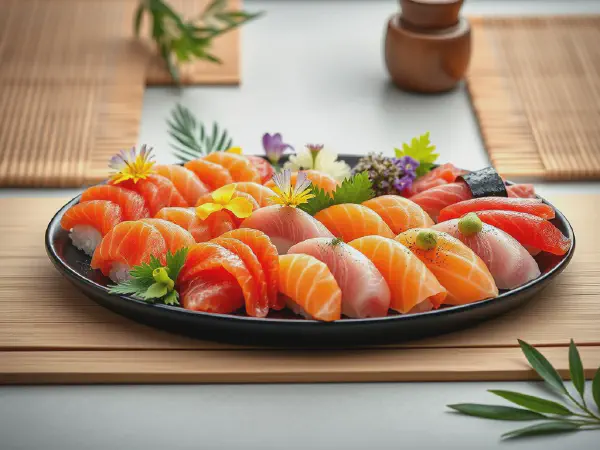Discover the Best Fresh Sashimi and Nigiri Near Me

Fresh Sashimi and Nigiri Near Me
If you're looking for a delectable dining experience, nothing quite compares to enjoying fresh sashimi and nigiri at local sushi restaurants. The phrase 'Fresh Sashimi and Nigiri Near Me' leads sushi enthusiasts on a quest for the finest, top-quality seafood prepared with precision and flair.
Finding the right spot for fresh sashimi and nigiri can be an adventure filled with flavors. Not only do these dishes highlight the natural taste of the fish, but they also showcase the skills of talented sushi chefs who take pride in their craft. Searching for 'Fresh Sashimi and Nigiri Near Me' often brings you to hidden gems and well-established favorites, each offering a unique twist on traditional recipes.
As you explore the various options, consider the ambiance and service. Many sushi restaurants provide a cozy atmosphere, making them perfect for dates, family gatherings, or simply enjoying a solo meal. With each bite of fresh sashimi and nigiri, you're not just indulging in a meal, but also experiencing the artistry embedded within each piece.
It's important to note that fresh sashimi and nigiri are not just about taste; they are also incredibly satisfying. The intricate flavors derived from quality fish paired with vinegared rice make every plate a culinary delight. Thus, finding 'Fresh Sashimi and Nigiri Near Me' is as much about the search for authentic flavor as it is about enjoying fresh, beautifully presented food.
For an authentic taste of Japan, discover the joy of dining with fresh options for Fresh Sashimi and Nigiri Near Me.
In conclusion, indulging in fresh sashimi and nigiri is a journey worth undertaking. Whether you're a seasoned sushi lover or trying it for the first time, discovering local places that serve these exquisite dishes is as exciting as the flavors they offer.
Local Sushi Restaurants
There are several top-rated sushi spots renowned for their fresh sashimi. Many of these restaurants pride themselves on sourcing high-quality fish directly from local suppliers, which ensures that every bite is a showcase of the freshest flavors available. Seeking out restaurants with strong reputations can lead you to experiences that highlight the beauty of this culinary art form.
Hidden gem sushi places often take the lead in providing exceptional sashimi and nigiri. These local joints may not always be prominent on social media but are treasured by the community. They often emphasize traditional techniques and serve menu items that are authentically prepared, allowing you to enjoy a unique dining experience without the tourist crowds.
Customer reviews on local sashimi and nigiri are also a vital aspect of the dining experience. Patrons frequently share their experiences, highlighting the freshness of the fish, the creativity of the presentations, and the overall quality of service. This feedback can guide new diners toward the best choices in their pursuit of 'Fresh Sashimi and Nigiri Near Me.'
Health Benefits of Sashimi and Nigiri
Fresh sashimi is loaded with nutritional value, rich in omega-3 fatty acids, protein, vitamins, and minerals. These elements make it a heart-healthy option that can be beneficial for maintaining proper cholesterol levels and promoting overall health. Eating sashimi also supports muscle growth and recovery due to its high protein content.
Nigiri is equally beneficial and can fit into a healthy diet. When made with brown rice or quinoa instead of white rice, this dish can offer a lower glycemic index and additional fiber. It’s a perfect option for those looking to balance taste with nutrition.
The benefits of consuming raw fish go beyond just nutrition; fresh sashimi can also help with weight management, as it is low in calories while high in essential nutrients. This makes it an excellent choice for anyone seeking to maintain a healthy lifestyle while enjoying delicious meals.
Sourcing Ingredients for Sashimi and Nigiri
To find the freshest seafood locally, it's essential to explore fish markets or trusted grocery stores specializing in seafood. Many sushi restaurants have established relationships with local fishermen, ensuring they receive prime fish every day—a practice crucial for serving quality sashimi.
Sourcing sustainable fish is becoming increasingly vital in the culinary world. Consumers are more aware of the impact that overfishing has on ocean health, making it crucial for sushi restaurants to prioritize sustainability. Selecting places that emphasize sustainable sourcing means supporting the environment while enjoying delightful meals.
Seasonal availability of sashimi-grade fish is another factor you should know. Certain fish are only at their peak in specific seasons, making it essential to check in with local suppliers regarding what's fresh at different times of the year. This knowledge can enhance your sashimi experience, as you'll be able to enjoy fish at its finest.
Making Sashimi and Nigiri at Home
Preparing sashimi at home can be an enjoyable process. Begin with selecting high-quality sashimi-grade fish, then focus on slicing techniques—angle and knife type are crucial for obtaining the best flavors. A step-by-step guide can help novices create beautiful plates that will impress anyone lucky enough to share in the experience.
To make nigiri at home, you will need essential tools such as a sharp knife for cutting fish, a rice cooker for sushi rice, and a bamboo mat for rolling. Having these tools on hand can significantly enhance the quality of your homemade sushi and make the process smoother.
When selecting the best fish for home preparations, consider local fish markets and restaurants that offer fresh products. Always inquire about the freshness and quality of the fish to ensure safety when preparing raw dishes. Additionally, being mindful of any recommendations from local chefs can elevate your home sushi-making experience.
Cultural Significance of Sashimi and Nigiri
The history of sashimi and nigiri dates back centuries in Japan, where these dishes were originally consumed as a means of preserving fish. Over time, they evolved into an art form celebrated for their unique flavors and presentation styles, marking them as staples of Japanese cuisine.
Culturally, sushi consumption encompasses practices like itamae (sushi chef's art) and omakase (chef's selection), highlighting the respect for traditional cooking techniques. These practices provide an immersive dining experience that showcases both artistry and craftsmanship behind each dish.
Regional variations of sashimi in Japan reflect local flavors and fish species. For instance, in Hokkaido, one might find a focus on uni (sea urchin), while in Kyushu, sweet shrimp may take center stage. These regional specialties add to the rich tapestry of flavors found within sashimi and nigiri culture.
